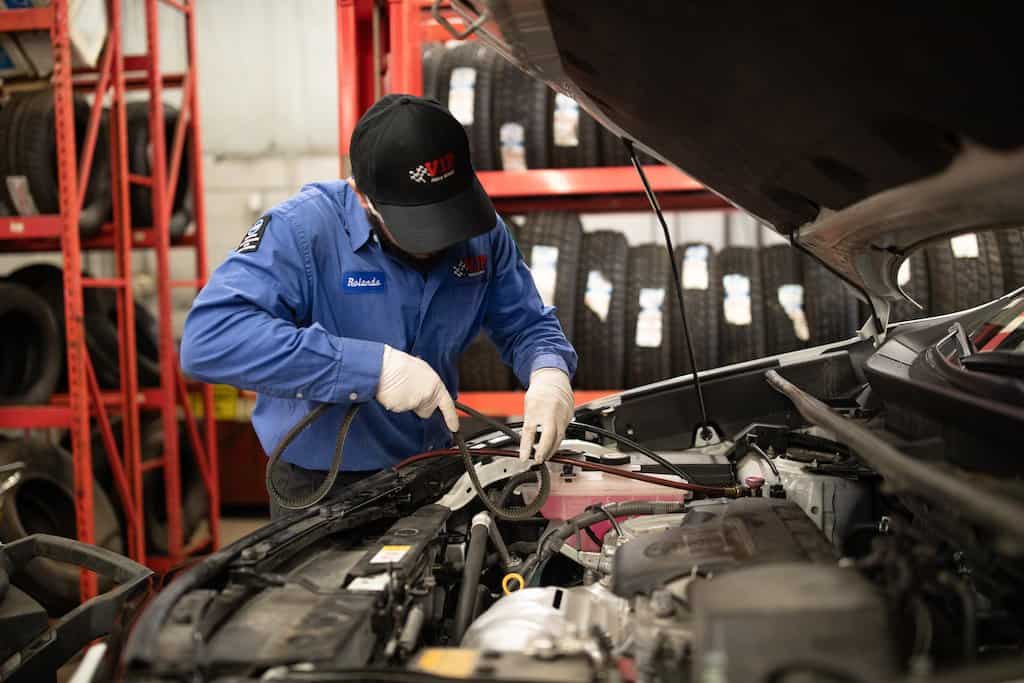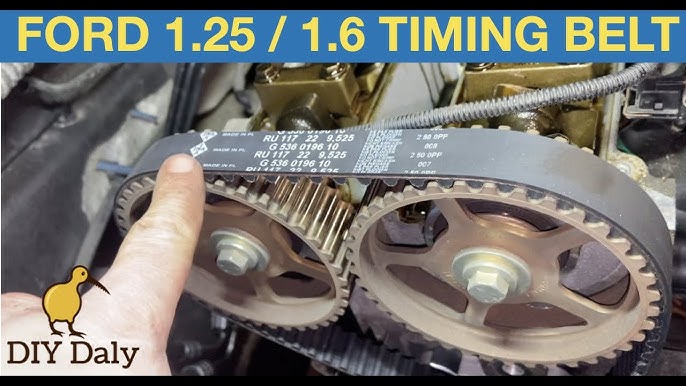Timing Belt Replacement: A Comprehensive Guide
When replacing a timing belt, it is crucial to follow manufacturer guidelines and replace it at recommended intervals to avoid costly engine damage. Regular maintenance and proper timing belt replacement ensures optimal engine performance and longevity.
A timing belt is a vital component of the engine, responsible for synchronizing the crankshaft and camshaft, and replacing it at the recommended mileage or time frame specified by the manufacturer is essential in preventing potential engine failure. This comprehensive guide will provide insights into the timing belt replacement process, including warning signs, cost factors, and the benefits of timely replacement.
Understanding the significance of timing belt replacement and following the necessary steps can save you from significant repairs and maintain your vehicle’s reliability.
Importance Of Timing Belt Replacement
Ensure timely replacement of the timing belt to prevent engine damage and costly repairs. Regular maintenance is crucial for optimal performance and reliability of your vehicle. Don’t overlook this essential maintenance task for your car’s longevity and smooth operation.
Signs Of A Worn-out Timing Belt
The timing belt in your vehicle plays a crucial role in the precise coordination of various engine components. Over time, this belt can wear out and lose its effectiveness. It is essential to stay alert to any signs of a worn-out timing belt to avoid potential engine failure or costly repairs. Here are some common indicators that your timing belt may need replacement:- Visible Wear and Tear: Inspect the timing belt regularly and look for signs of fraying, cracking, or missing teeth. A deteriorating belt is a clear indication that it needs immediate attention.
- Unusual Noises: A worn-out timing belt can cause strange noises coming from the engine compartment, such as squealing or grinding sounds. These noises typically become more noticeable as the belt gets closer to failure.
- Engine Misfires or Stalling: If the timing belt is worn-out, it can disrupt the synchronization between the crankshaft and the camshaft, leading to engine misfires or even stalling. This can be a serious safety hazard, especially while driving at high speeds or in heavy traffic.
- Visible Oil Leaks: A deteriorating timing belt can cause oil to leak onto the belt itself. If you notice oil deposits on the surface of the belt or surrounding engine components, it is essential to have your timing belt inspected and replaced if necessary.
- Engine Overheating: As the timing belt wears out, it can cause the engine to overheat due to the disruption in the cooling system’s timing. If you notice your engine temperature gauge consistently rising or frequent overheating, it is crucial to check the condition of your timing belt.
Cost Of Delaying Timing Belt Replacement
Delaying the replacement of a worn-out timing belt can have severe consequences for both your vehicle and your wallet. While it may seem negligible to put off this maintenance task, it is essential to consider the potential risks and expenses associated with procrastination. By delaying timing belt replacement, you run the risk of your belt snapping while driving, leading to significant engine damage. The timing belt connects the crankshaft and the camshaft, ensuring the perfect timing of engine operations. A broken belt can cause extensive internal engine damage, including bent valves, damaged pistons, or even a complete engine seizure. The cost of repairing such damage far exceeds the expense of simply replacing the timing belt in a timely manner. Depending on the extent of the damage, you may need to replace other engine components, including valves, pistons, and possibly even the entire engine itself. These repairs can cost thousands of dollars, significantly more than the cost of a routine timing belt replacement. Apart from the financial burden, a broken timing belt can leave you stranded on the side of the road or in a dangerous situation. Considering the potential risks to your safety and the inconvenience of unexpected breakdowns, it is clear that delaying timing belt replacement is not a wise choice. By proactively replacing your timing belt according to your vehicle manufacturer’s recommendations, you will prevent potential engine damage, avoid costly repairs, and ensure a reliable and safe driving experience. Remember, neglecting this vital maintenance task can have long-term consequences that are best avoided.
Credit: servicemycar.com
When To Replace A Timing Belt
Timing belt replacement is crucial to avoid potential engine damage and maintain optimal performance of your vehicle. It’s essential to be aware of the appropriate timing for this preventive maintenance.
Manufacturer’s Recommendations
Car manufacturers provide specific guidelines for timing belt replacement, and it’s imperative to adhere to their recommendations. These guidelines are based on extensive testing and are designed to prevent potential belt failure.
Mileage And Time Intervals
Most manufacturers suggest replacing the timing belt between 60,000 to 100,000 miles, or every five to seven years, whichever comes first. However, this may vary depending on the make and model of the vehicle. It’s crucial to consult your owner’s manual or a certified mechanic to determine the precise timing belt replacement interval for your specific vehicle.
Diy Vs. Professional Replacement
When it comes to timing belt replacement, choosing between DIY and professional replacement is a critical decision. Both options have their benefits and drawbacks, so it’s essential to weigh the factors before making a choice.
Tools And Skills Required For Diy Replacement
For a DIY timing belt replacement, it’s crucial to have appropriate tools such as a wrench set, socket set, torque wrench, and a timing belt tensioner tool. Additionally, proficiency in tasks such as removing the old belt, aligning gears, and tensioning the new belt is necessary.
Benefits Of Professional Replacement
Professional replacement provides assurance that the job will be done correctly. Skilled technicians have the necessary expertise and access to advanced tools and equipment, ensuring precision and reliability in the replacement process.

Credit: www.vipauto.com
The Timing Belt Replacement Process
Get a comprehensive guide to timing belt replacement. Learn about the process, steps, and importance of replacing your timing belt to ensure the smooth operation of your vehicle’s engine.
Introduction: The timing belt is a crucial component of your vehicle’s engine, responsible for synchronizing the rotation of the crankshaft and camshaft. Over time, the timing belt can wear out or become damaged, requiring replacement. In this comprehensive guide, we will walk you through the timing belt replacement process, from the initial inspection to the step-by-step replacement procedure. H3: Initial Inspection Before diving into the replacement process, it is essential to conduct a thorough initial inspection of the timing belt. This assessment will help you determine if the timing belt is in need of replacement or if any other issues need attention. Here’s what you need to do: 1. Examine the timing belt for signs of wear or damage, such as cracks, fraying, or excessive looseness. 2. Look for any oil leaks in the vicinity of the timing belt, as oil can degrade its rubber composition. 3. Check the tension of the timing belt to ensure it is within the manufacturer’s specifications. 4. Inspect the timing belt pulleys for signs of wear or misalignment, as these can lead to premature belt failure. By conducting this initial inspection, you can assess the condition of your timing belt and determine whether replacement is necessary. H3: Step-by-Step Replacement Guide Once you have concluded that your timing belt requires replacement, it’s time to embark on the step-by-step replacement process. Follow these instructions carefully to ensure a smooth and successful replacement: 1. Make sure you have the necessary tools and equipment, including a wrench, socket set, and a new timing belt suitable for your vehicle’s make and model. 2. Begin by disconnecting the negative battery cable to prevent any electrical mishaps during the replacement process. 3. Remove any necessary components to gain access to the timing belt, such as the engine covers or other accessories. 4. Loosen the tensioner pulley and slide it away from the belt, relieving the tension and allowing for easy removal. 5. With the tension released, carefully remove the old timing belt from the pulleys, taking note of its routing for future reference. 6. Before installing the new timing belt, ensure that all pulleys are clean and free of debris or oil. 7. Carefully thread the new timing belt onto the pulleys, following the manufacturer’s guidance for proper routing. 8. Once the belt is in place, release the tensioner pulley to apply tension to the belt, ensuring it is aligned properly on the pulleys. 9. Rotate the engine manually to ensure the timing belt is properly aligned and seated correctly on all pulleys. 10. Reinstall any components that were removed during the access process, ensuring everything is securely fastened. 11. Reconnect the negative battery cable and start the engine to test the new timing belt’s performance. By following these step-by-step instructions, you can successfully replace your timing belt and ensure that your engine operates smoothly and efficiently. Remember, if you are unsure or uncomfortable with performing the timing belt replacement yourself, it is always recommended to seek the assistance of a qualified mechanic.Choosing The Right Timing Belt
When it comes to timing belt replacement, selecting the right timing belt is crucial. Understanding the types of timing belts available and the factors to consider will ensure smooth and efficient engine operation.
Types Of Timing Belts
There are two main types of timing belts: rubber belts and timing chains. Rubber belts are more common in modern engines, offering cost-effectiveness and ease of installation. Timing chains, on the other hand, are known for their durability and longevity.
Factors To Consider When Selecting A Timing Belt
- Engine Compatibility: Ensure the timing belt matches the specifications of your engine.
- Material Quality: Opt for high-quality materials to prevent premature wear and tear.
- Manufacturer Reliability: Choose a reputable manufacturer for reliability and performance.
- Maintenance: Consider the maintenance requirements of the timing belt for long-term durability.
- Cost: Balance cost with quality to find a timing belt that meets your budget and performance needs.

Credit: m.youtube.com
Frequently Asked Questions Of Timing Belt Replacement: A Comprehensive Guide
Do Timing Belts Have Guides?
Yes, timing belts have guides. These guides help maintain proper alignment and tension of the belt. Proper alignment and tension are crucial for the timing belt to function effectively and prevent engine damage.
How Critical Is Timing Belt Replacement?
Timing belt replacement is critical as it prevents engine damage. It’s recommended every 60,000-100,000 miles. Ignoring it can lead to costly repairs. Regular maintenance is key to engine longevity.
What Else Should Be Replaced When Replacing Timing Belt?
When replacing a timing belt, it is important to also replace the timing belt tensioner and idler pulleys. These parts work together and can wear out over time, so it is best to replace them all at once to ensure optimal performance and prevent future issues.
Do Timing Belts Really Need To Be Replaced?
Timing belts should be replaced as per manufacturer’s recommendations to prevent engine damage. Regular maintenance is crucial for optimal performance and longevity.
Conclusion
To ensure the longevity of your vehicle’s engine, it is crucial to stay on top of timing belt replacement. By following this comprehensive guide, you have equipped yourself with the knowledge needed to tackle this essential maintenance task. Remember, regular inspections and timely replacement will save you from potential disasters down the road.
Your car will thank you for it!

